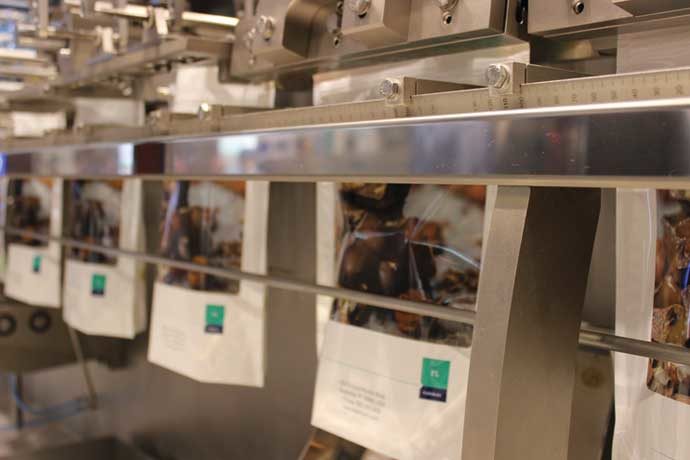The words “meat snack” might evoke an image of flavored beef jerky in a grab-and-go container sitting on a gas station counter. However, more and more, meat snacks are not just relegated to cashier stands but are a portable part of everyday nutrition.
According to a 2019 report by Mintel, 95% of US adults snack daily and 70% snack twice a day. Meat snack options are increasing as consumers shop for healthy protein choices.
Drawing consumers to a product is one of the main goals of a successful packaging solution, but meat snack packaging is also challenged by offering more environmentally sustainable options that can meet the barrier requirements to extend shelf life and provide cost-effective efficiency to processors.
“Our category [meat snacks] has been very grab-and-go for a long time, but it is trending toward planned consumption,” said Ben Rudman, chief executive officer at Western’s Smokehouse and its subsidiary, Thrushwood Farms.
This means there is an increased interest in multi-packs instead of individually-wrapped snacks. This works well with the three priorities for the Greentop, Mo.-based co-packer: convenience, price point and sustainability, Rudman said.
 Source: Amcor
Source: Amcor
At Amcor Flexibles of North America, anti-grease film technology is being used in some of its packages. The company uses a proprietary sealant that goes into the lamination process, said Pete Bruehl, senior marketing manager of meat, poultry, and seafood packaging at Amcor, with US offices in Buffalo Grove, Ill.
This can be paired with Amcor’s high barrier, flexible snack pouch material that can be printable in up to 10 colors that best showcase a brand’s product.
“The new pouch offers reduced supply chain and lamination complexity for shortened delivery times, and superior flexed barrier for better product quality with extended shelf life,” Bruehl said.
By streamlining the multiple lamination steps necessary to make shelf-stable packaging, Amcor’s customers can save on production costs.
Amcor has created a whole portfolio called AmPrima to focus on sustainable packaging solutions. The packaging is designed to be recycled through in-store or curbside drop-offs. Not only is AmPrima meant to be recycled, but about 50% of the carbon footprint savings come from the production of the packaging itself.
“By 2025, we want to have films available or alternatives to existing products that we have, so customers have the option to go with our current film or sustainable options,” Bruehl said.
Standing out
As consumers look for healthier protein-rich snacks and environmentally conscious brands, meat snack companies need to differentiate themselves in the stores. Meat snack brands have their own sustainable production metrics that they are trying to reach, and those decisions can determine the types of packaging solutions used for some of their products.
 Source: Novolex
Source: Novolex
Incorporating recycled content in meat snack lids and base packaging allows companies to reach some of their sustainability goals, said Adrianne Tipton, chief technology officer for Hartsville, SC-based Novolex.
“There is definitely migration toward less plastic, more polystyrene, and adding more post-consumer recycled content or compostable additives,” she said.
Incorporating these compostable and recyclable materials into packaging has its own challenges though.
Educating consumers is an important first step. Not all recyclable films are accepted in at-home recycling programs, but instead, most need to utilize specific drop-off at retail locations. Recyclable packaging also needs to be clean and dry before it is recycled, which poses a larger challenge to meat packages because these products tend to have higher moisture and fat content.
Finally, there is only a limited amount of recycled polyethylene terephthalate (rPET) and polystyrene with recycled content available for packaging companies to use. Sourcing multiple types of materials for different aspects of meat snack packages can be difficult and sometimes virgin materials offer a better price than recycled plastic or polystyrene, Tipton said.
Recycled material can also impact the clarity of the clear packaging, making it difficult for customers to see the product itself. It’s important to find the right mix of barrier technology that can keep a meat stick or piece of jerky fresh for about 18 months. Novolex has also been working with some antimicrobial additives on lids and bases to reduce contamination.
Peelable labels that can be reclosed for later consumption are common in meat snacks and expiring labels can help processors and retailers reduce waste.
The labels allow retailers and consumers to “have an indication of when the meat or product will expire based on a time-temperature label, instead of just a date-code stamp,” Tipton said.
Sustainability meets innovation
Packaging companies are finding the balance between sustainable solutions and innovative designs that allow brands to compete on the ever-growing market for meat snacks.
Matrix Packaging Machinery – a Saukville, Wis.-based ProMach brand – uses FLtècnics flexible packaging to combine efficiency with consumer marketability.
“People generally don’t consume the entire bag in one sitting. They’re opening it, taking a piece out, and reclosing it,” said Spencer Johnson, regional sales manager for Matrix. “That bag of snacks may be consumed over a period of a few days.”
The FLtècnics packages with zippers have been the most popular design for meat snacks because they maintain freshness better than hook-and-loop (velcro) closures.
FLtècnics is a cost-effective solution because the product line can do long production runs with rollstock from a horizontal form-fill-seal with the zipper added after, Johnson said.
“They offer automatic changeover, along with the ability to be preloaded with two rolls of film, which make changeovers fast and efficient,” Johnson said. “The films can also be either 100% recyclable and/or compostable.”
The market for meat snacks is growing. The plastic tongs used to grab a sheet of beef jerky on cashier stands aren’t going extinct, but consumer trends are shaping how processors package and market today’s more refined meat snacks.


